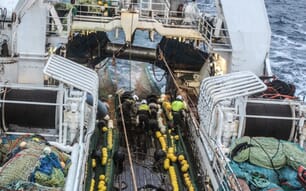Haddock are more fragile and susceptible to stress during catching than cod, meaning that the flesh easily splits and falls apart after slaughter. The fish can become so difficult to process that it becomes unsaleable or downgraded, meaning that the fishing industry often incurs major losses.
The first key challenges related to haddock quality relate to the fact that the fish are processed after a few days of cold storage, which results in soft muscle. The second is blood in the muscle that largely arises from catching and handling on board.

In a bid to solve these problems, Norwegian researchers have initiated a number of trials involving live storage of haddock on a fishing vessel between capture and slaughter. Researchers from Nofima, the Institute for Marine Research and Sintef Ocean undertook trials on the fishing vessel M/S Ballstadøy, off the Finnmark coast.
They made several hauls with seine nets for haddock. Along the way different fishing gear configurations were tested to achieve the best possible survival.
After catching, the haddock were kept alive in tanks and delivered to the Båtsfjord processing facility, to be slaughtered and processed. The delivery of live stored fish allowed for filleting of super-fresh haddock, which resulted in fillets without splitting and with little blood.
“The fillets we obtained from this looked like jewels. We obtained fillets of amazing quality that the Båtsfjord facility could produce to high quality products,” enthuses researcher Torbjørn Tobiassen.
The trial involved optimizing conditions for the fish in the fishing gear. Among other things, an extender was used that provides more room in the purse seine when hauling in the catch. More room results in less strain and a greater chance that the fish can breathe freely, which may affect survival and the amount of blood in the muscles.
“The haddock were remarkably calm when they came on board and were left alive in the tanks. We expected more stress, but only individuals expressed such behaviour. Animal welfare experts observed the fish in the tanks, and reported that they were very calm and doing well. In the trials, a survival rate of up to 80 per cent was achieved 12-18 hours after catching,” Tobiassen says.
When the haddock were slaughtered the next day, they were processed immediately.
“The Båtsfjord facility reported a significant quality improvement. They could cut whole, fine fillets with very little blood compared to traditional catches. There were no limitations to their production, and according to the employees this was a raw material that was very easy to work with,” Tobiassen says.
According to the processing firm, loins could be obtained from all live captured haddock and the proportion of high quality products increased by 25 per cent.
“Haddock is a significant resource, but there is a lot of potential in terms of enhancing the quality in the value chain. We know that large individual catches, long transport times and storage in bulk causes product quality to significantly deteriorate. If we manage to develop effective solutions for alternative handling of fish, everyone in the value chain may benefit,” Tobiassen says.
The project is funded by FHF (the Fishery and Aquaculture Industry Research Fund) in close cooperation with industry partners (Båtsfjordbruket AS, Lerøy ASA and Nergård AS).



